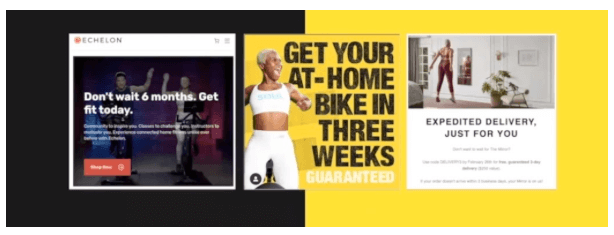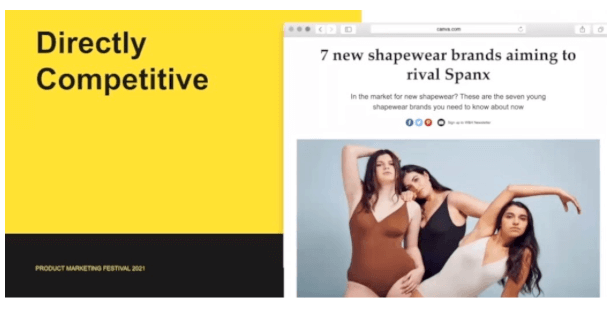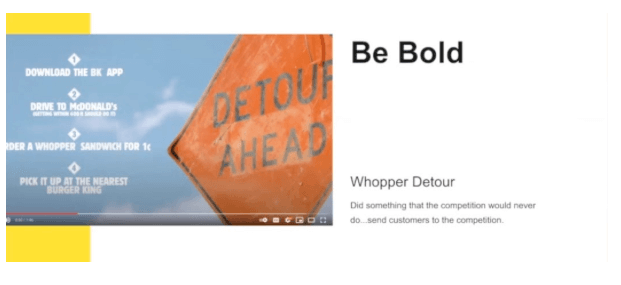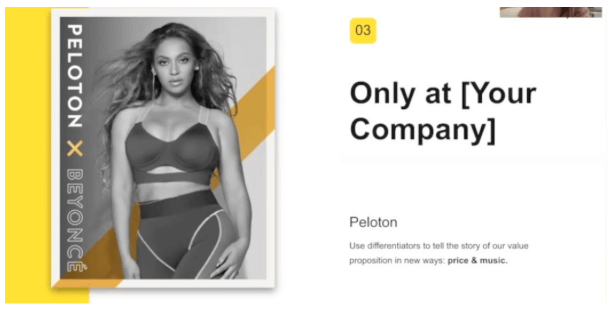Ali Wiezbowski, Dir. of PMM at Peloton Interactive, gave a presentation on this topic at the Product Marketing Festival 2021. Watch presentations onDemand now.
My name is Ali Wiezbowski, I'm the Director of Product Marketing at Peloton. I lead our global bike product marketing team, and I've been in a lot of different types of marketing organizations with different companies.
I’ve been in marketing at organizations across a lot of different stages, most recently with category-creating and category-leading Peloton.
In this article, I’ll talk about what it means to be a PMM in this environment, and share key experiences, tips, and examples for how to nail the product marketing role therein, focusing specifically on:
- Definite category-creating and leading products
- Case studies from recent years
- The rub for PMMs
- What you can do as a PMM, and
- 3 tips for breakthrough product marketing
I started my career at Microsoft, and spent four years since then running my own business; before joining Peloton, I led the earner engagement product marketing team at Uber. Along the way, I've become a huge advocate for product marketing.
I’m a strong believer in infusing user needs and adoption goals, not only into product design but how we bring new products to market.
I'm going to talk about what it means to be a product marketer at a category-leading company and share some of my experiences working at companies that have actually created those categories in which they are leading.
Definite category-creating and leading products
First, let's start by defining and identifying across the landscape what category-creating and category-leading companies are.
I'm going to talk about two different types of companies. There are category creators and category leaders.
Category creators
Category creators have both a breakthrough product and a breakthrough business model.
Category leaders
By contrast, a category leader has the largest market share or the largest percentage of total sales in the given market they operate in.
While these are often the same, they're not necessarily always identical.
Category creators and market share
The category creators have an opportunity to create the market and accelerate their leadership because they're innovating on their business model; they've identified a new consumer need and a new product that has a tonne of opportunity.
What's exciting is category creators are often the same as those that are the category leaders. A study by HBR showed category-creating companies often take about 76% of the market share of the categories they created. That's really, really powerful.
They're able to do that by being first to market, by accelerating their learnings, their awareness, their conversion, and adoption. While it's risky, it can be worth it for them.
They've found a product people want, and more importantly, a product people need. They can deliver it in new, innovative ways that enable them to scale more quickly than someone who has a product in a more established category.
This creates a big opportunity for product marketing to play a key role in the growth and maintenance of that leadership position when you're creating a new category.
Examples from the last few years
Here are a few of my favorite examples of the past couple of years. Products many of us know, use, love, advocate for and I've had the fortune of working at a few of them.
Uber: Rideshare
Uber certainly created and accelerated its leadership position in the rideshare market, maintaining the largest rideshare footprint globally across a very, very competitive landscape.
Spanx: Shapewear
Spanx dominates the shapewear market, created by Sara Blakely, one of my all-time favorite entrepreneurs.
White Claw: Hard Seltzer
None of us could ignore the growth and acceleration of White Claw over the past few years. They've grown spiked seltzer into a $550 million industry.
Peloton: Connected Fitness
And most recently, and one of course that I'm at now, Peloton has really invented, innovated, and accelerated their leadership position in the connected fitness space and is expanding globally in the US, UK, Canada, Germany, France, and soon in Australia.
The rub for product marketers
Here's the rub as a product marketer at one of these companies: When you're a market leader, you've proven that there's an entirely new category available, that there's a lot of demand, and by doing that, you eliminate the risk for other entrants.
As a default, what you're going to see is being a PMM at one of these companies is a little bit of a double-edged sword. You have the responsibility of maintaining your leadership position. But everything you do that works, it's very likely that your competitors are going to come in and use what they've learned from your success.
It’s up to you to innovate, and figure out creative new ways on how to maintain and accelerate category growth overall but also maintain your leadership position in it.
I've observed a couple of trends when this happens. When you come in, and you've identified a huge category, tonnes of demand, and many competitors and lookalike products start following suit.
Advertising & comms
One of those things is you'll start to see is advertising and communications across the landscape of competitors start looking very similar.
This is a set of a few different advertisements that we pulled during a time earlier in the year when Peloton was having some challenges getting bikes to prospective customers quickly.

What you'll see is that Echelon, Soul Cycle, and many others started advertising based on the time they could get their products to their customers.
This is a signal that as market entrants come in, you're going to start seeing very similar messaging coming in at the top of the funnel. Which presents a bigger challenge as a marketer and as a leader: how can you continue to differentiate when the market is often using a lot of shared messaging?
Direct competition
You're also going to see your competition get fierce, and those other products look at what your weak points are, and try to unlock other areas of potential demand to try and capitalize on this.

The above example highlights this perfectly. You’ll start to see headlines even where consumers are going to start wanting to know what's the difference between your product and all the others.
In doing so your leadership position gets scratched away by several other products and brands entering the market.
What can you do as a product marketer?
As a product marketer, what are you supposed to do when you're part of one of these organizations?
The things you've delivered to the market are successful. They’re so successful that other entrants are coming in and trying to use these tried and tested methods to market their products.
What are you going to do as a market leader, when you've opened up demand, and other entrants have come in? How can you maintain and accelerate category growth, as well as maintain your leadership position inside of it?
In my experience, I’ve come across two big learnings that have helped us move onto the next chapter:
1) Accept it
As a product marketer at one of these organizations, you need to accept the reality that you are both a category leader and a competitive product.
What that means is as the leader, you have a responsibility and an opportunity to continue to educate consumers about the overall category, as well as your product's unique space to occupy in it and your leadership position in the mix of opportunities.
It takes a special skill to strike a fine balance between marketing your product, advocating for the core reasons to believe in value propositions of your category overall, whilst making sure you hone in on the unique ways your product is different and better than the competition.
2) Find a new way in
The second big learning I want to talk about is what I call ‘find a new way in’.
As a product marketer, if you've found a message that works, you don't want to walk away from it. But every message can be communicated in a multitude of ways in unique differentiated channels.
My advice is that as a product marketer in one of these category-creating or category-leading companies, it is your responsibility to find a new way in, to make that evergreen RTB break through and resonate in a new way.
Find a way to tell that story in a way only you can; this’ll help achieve greater resonance and impact for your business.
3 tips for breakthrough product marketing
Now, I'm going to talk about three tips I've uncovered for how to find a new way in once you are in the process of educating consumers on the category you're in, as well as being tasked from the business with accelerating or maintaining your leadership position in it.
Along the way, I'm going to share a couple of my favorite examples from other categories, as well as a few stories from Peloton about how to make this successful:
1) Feeling > function
As product marketers, we love to look at features and functionality.
But if you've created a market, and other entrants have come in, it's very likely they are going to lean on similar functions and features for their product to get the adoption in the market and compete.
Shot on iPhone
I found the Shot on iPhone campaign, one many of you have probably seen across skylines and billboards in your city, as this is a perfect manifestation of how Apple is demonstrating feeling over function.

Rather than talking about whether they have one camera, or two cameras, or three cameras, or how many megapixels their photos capture, it shows you what a photo can do - what a beautiful photo can do powered by an iPhone, and how it makes you feel about the world around you, about daily life.
I think this is an incredibly savvy and nuanced campaign. By contrast, when you look at Samsung, for example, their ads often show hardware and multiple cameras.
The iPhone has those too but what Apple is doing is focusing instead on the output of those features and the way that output makes you feel. I think it's incredibly savvy and sound product marketing.
It's been one of the campaigns I've ever seen with the longest run in any city. Really powerful, really flexible, really globally extensible. I think it does a really important job of demonstrating that when you put feeling over function, you can actually create an even greater breakthrough with your audience over time.
2) Be bold
The second big learning I've found is around being bold. As a market leader, you get to focus on a couple of other things, you don't have to focus as much on awareness or certain products because you're ahead in the market.
Whopper Detour
One of my favorite examples of being bold is a campaign called the Whopper Detour. If you have not seen this, you should absolutely look it up.

Interestingly, Burger King is actually not the market leader in terms of total burgers sold or the most usage of their delivery app. But they are willing to be bold in a way that their competition was not.
What they did was encourage their customers to go to the competition. If they downloaded the app and drove up to a McDonald's, only then could they order a whopper for a cent.
What is so brilliant about this is they were willing to be bold and breakthrough and so much more differentiated than some of the things we typically see from their category and competition. It had a real impact.
They were able to drive a million app downloads in a very short period. During that time, they were also able to jump ahead of McDonald's app on the App Store. I think it's a really important thing to think about.
As a leader, how do you act as a leader? How do you act boldly in your category to continue to drive awareness, adoption, and engagement from your customers?
3) Only at [your company]
My final tip is one of my favorites. I'm going to talk about an example from Peloton; it’s what I like to call Only at [insert your company here].
The prior area of focus on being bold is really about what your company is willing to do. However, this third and final tip is about identifying the things that only your company can do based on its position, and often, its position of leadership and category creation.
This is about looking for things that your competitors cannot, and doing things in breakthrough, bold, ambitious ways because of what you've built along the way.
I'm going to look at Peloton as an example here, and I'm going to talk about two different examples.
Peloton: Price
Price is a big barrier for our customers. We understand it’s a high ticket item and we hear that a lot, especially when prospective customers are asking themselves, “am I really going to use this thing?”
Key differentiator
We actually know the answer is yes. Definitively, yes. Our members love it, our engagement and retention are some of the highest rates I've ever seen in the industry. So, there's a real opportunity to think about the price within that context and tell that story much differently than we ever have before and much differently than any of our competition can.
Value proposition
What's really interesting, and what you'll see coming to market soon, is we recently used a combination of third-party and proprietary data to tell a story to our prospective customers around price and value in a way we never could have before.
What you'll see in the market is a quite functional, direct message that a Peloton is very much worth the cost and incredibly cost-effective. Because we know our customers use the product so much.

Peloton: Music
The second example is a bit less of the functional evergreen RTV and looks a little bit at how we deliver an amazing and differentiated experience, which is rooted in our relationship with the music industry.
Music is an incredibly important part of our experience and simply put, there's no other connected fitness product out there that could and does have a partnership with the Queen herself Beyonce.
We are incredibly dedicated and committed to our relationships in the music industry and we were looking for some interesting ways to share that story. I wasn’t on the team at that time, but this has been one of the most successful things our team has done along the way.
Key differentiator
We leaned into our differentiator around our relationship with the music industry and what we saw was the Beyonce-themed classes, partnership, and the ability to bring membership to historically black colleges and universities were some of the efforts our team was most proud of.
It spoke to our values and unique differentiators and did so in a way that only Peloton could do.
Based on those three things, I hope all of you have an opportunity to work at category-leading companies. It is incredibly exhilarating, but also incredibly challenging.
I hope you find these three tips helpful along the way.
Thank you.


















 Follow us on LinkedIn
Follow us on LinkedIn



.svg?v=f84e366086)